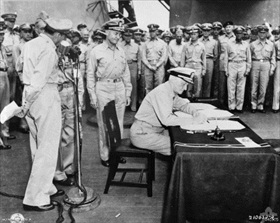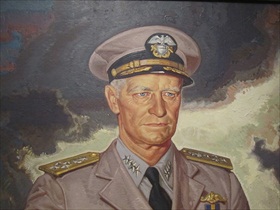ADM. CHESTER W. NIMITZ TO HEAD U.S. PACIFIC OPERATIONS
Washington, D.C. • April 3, 1945
On this date in 1945 the Roosevelt administration appointed Gen. Douglas MacArthur Commander-in-Chief U.S. Army Forces Pacific (AFPAC), responsible for all Army and Army Air Forces units in the Pacific Theater excepting Maj. Gen. Curtis LeMay’s Twentieth Air Force based in the Marianas. At the same time Adm. Chester W. Nimitz became Commander-in-Chief, United States Pacific Fleet (CINCPAC). These moves were part of the preparations for Operation Downfall, the invasion of Japan set to begin in October 1945.
MacArthur, who was recalled to active duty in June 1941 to mobilize the Philippine Army, was appointed Supreme Commander of the Southwest Pacific Area (SWPA) upon its creation in April 1942. (SWPA was 1 of 3 areas in the Pacific Theater; the other 2 were Pacific Ocean Areas (POA) and the Southeast Pacific Area.) From that post MacArthur moved on to head the Allied occupation of Japan (1945–1951). Ten days after the Japanese surprise attack on U.S. military installations at Pearl Harbor, Hawaii, Nimitz was appointed Commander-in-Chief, United States Pacific Fleet (CINCPACFLT). In March 1942 Nimitz was elevated to Commander-in-Chief, Pacific Ocean Area (CINCPOA), which placed all U.S. and Allied air, land, and sea forces under him. On December 15, 1944, President Franklin D. Roosevelt appointed Nimitz to the rank of Fleet Admiral of the United States Navy, a 5‑star rank only established the previous day by an Act of the U.S. Congress.
In the last 14 months of the war, Nimitz’s Fleet Forces inflicted a decisive defeat on the Japanese in the Battle of the Philippine Sea (June 19–20, 1944); captured Saipan (June 15–July 9, 1944), Guam (July 21–August 10, 1944), and Tinian (July 24–August 1, 1944); and secured in rapid succession Peleliu (September 15–November 27, 1944), Angaur (September 17–October 22, 1944), and Ulithi (September 1944), which became the undisclosed Pacific base for major naval operations late in the war. In the Philippines his ships scored an historic victory in the Battle of Leyte Gulf (October 24–26, 1944).
Nimitz culminated his Pacific strategy by successful amphibious assaults on Iwo Jima (February 19–March 26, 1945) and Okinawa (April 1–June 22, 1945) and an aerial assault in late March and April 1945 on the Japanese Home Islands with the mining of vital seaports, straits, and inland waterways using B‑29 Superfortresses dispatched by LeMay’s Twentieth Air Force (Operation Starvation). The late-in-the-war mining campaign crippled Japanese merchant shipping and troop movements, destroying or damaging 670 vessels. Had the mining operation begun earlier, in a July 1946 estimate from the U.S. Strategic Bombing Survey, the Pacific War might have ended sooner.
When Japan’s armed forces and the forces under its control formally surrendered on September 2, 1945, on board the USS Missouri in Tokyo Bay, Nimitz was there, signing for the United States of America. The 23‑minute surrender ceremony was broadcast around the world.
Five-Star Admiral Chester W. Nimitz (1885–1966), Commander of the Pacific Ocean Theater
 |  |
Left: Japanese surrender aboard the USS Missouri, Tokyo Bay, September 2, 1945. Adm. Chester Nimitz signed the Instrument of Surrender for the United States. At the microphone is Gen. Douglas MacArthur, Supreme Commander for the Allied Powers, who accepted the Japanese surrender “for the United States, Republic of China, United Kingdom, and the Union of Soviet Socialist Republics, and in the interests of the other United Nations at war with Japan.” On September 7 the surrender document was presented to President Harry S. Truman in a formal White House ceremony and then placed on exhibit at the National Archives.
![]()
Right: Adm. Chester Nimitz as he appears at the National Portrait Gallery in Washington, D.C. Nimitz was 1 of only 4 Fleet Admirals in the U.S. Navy. A Fleet Admiral takes orders only from the President of the United States, and it is a lifetime appointment.
The Adm. Chester Nimitz Story, a U.S. Army “Big Picture” Film
![]()

 History buffs, there is good news! The Daily Chronicles of World War II is now available as an ebook for $4.99 on Amazon.com. Containing a year’s worth of dated entries from this website, the ebook brings the story of this tumultuous era to life in a compelling, authoritative, and succinct manner. Featuring inventive navigation aids, the ebook enables readers to instantly move forward or backward by month and date to different dated entries. Simple and elegant! Click
History buffs, there is good news! The Daily Chronicles of World War II is now available as an ebook for $4.99 on Amazon.com. Containing a year’s worth of dated entries from this website, the ebook brings the story of this tumultuous era to life in a compelling, authoritative, and succinct manner. Featuring inventive navigation aids, the ebook enables readers to instantly move forward or backward by month and date to different dated entries. Simple and elegant! Click 











